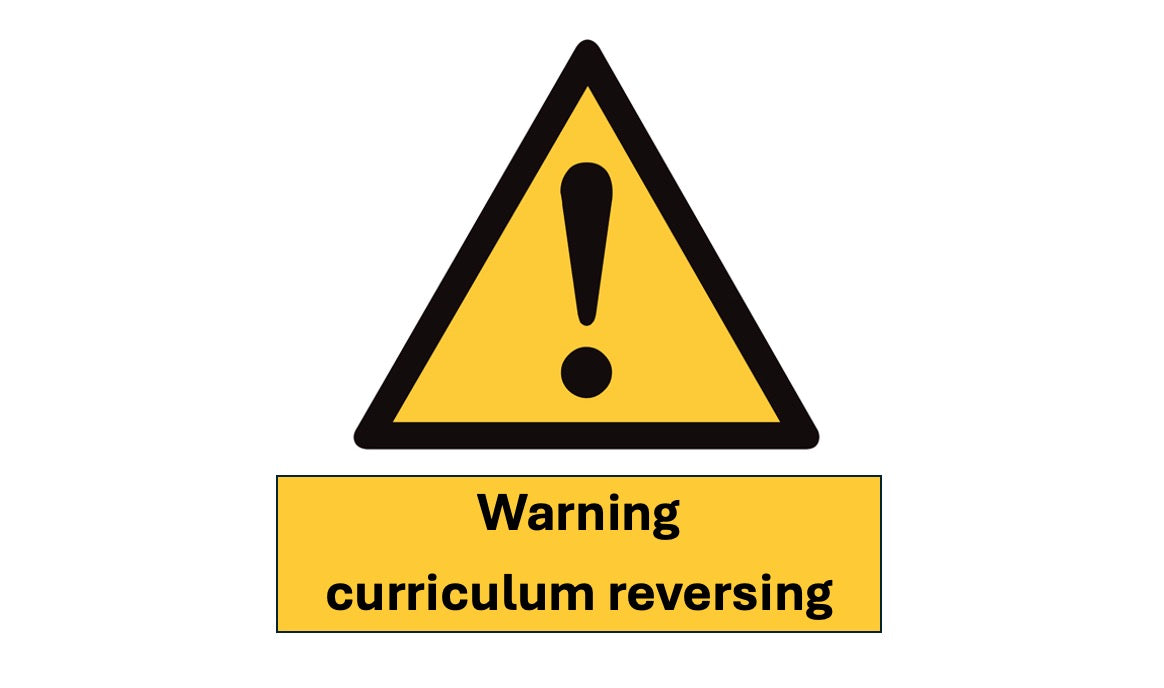Warning: national curriculum reversing
It looks like England’s education system is about to change direction yet again. A major parliamentary report called on Government to reverse its 'knowledge-rich approach' and fix a curriculum that's now 'overloaded with content'. Basically, their conclusion was that those ‘tough and rigorous’ reforms we were told were vital 10 years ago took us 'in the wrong direction'. That's certainly the view I came to in reporting the slow decline in our PISA results.
So does that mean future staffroom conversations will be more about group projects and investigations, than knowledge organisers and oak academy videos. Hope so.
Before rather than accelerate towards a more future-looking curriculum, we should step on the brakes and reflect. Since 1989, I've lived through 10 different versions of the national curriculum. I'd like to offer some lessons learned for policy makers learn some lessons so that we avoid a curriculum car crash next time around.
1. Test what matters
Perhaps the most critical part of the system to change is external assessment because its tentacles influence all other components in the system. The basic principle is to make sure we’re assessing the things we value - the aims and outcomes. Otherwise assessment will continue to distort and demean teaching and learning. Let’s look at innovative models from elsewhere and not leave the job to awarding bodies.
2. Remember the humans
Ministries of education often make a category error. They think that reforming a curriculum is like constructing a new road - a technical project where everything is known at the beginning and the output is predictable. But it’s not. Reform is a complex project with many unknowns and has to pass relatively unscathed through many layers of people, with their existing motivations, beliefs and practices. Impact will only happen if they understand the benefits, are given some autonomy, and have the capacity to change.
4. Choose life-worthy content
David Perkins talks about ‘knowledge for …’ It’s only useful in what it allows students to do. Although we don’t know what the future will be like, we should place bets on that students are most likely to need based on the lives they are most likely to lead - that’s life worthy content. Most of the current curriculum is not life worthy and should be culled, or reduced to the level of ‘acquaintance’ knowledge, since if it’s not useful it will be largely forgotten. With the reclaimed space, schools can focus on help students use their knowledge and develop the skills they need. Why not allow them to choose from a range of curriculum offerings that best meet their students needs?
5. Use research wisely
The ‘knowledge rich’ curriculum may be based on some research but its rear-view-mirror philosophy about knowing the best from the past dodged the question of what’s lifeworthy. Let’s remember that in education, there are only small theories, which apply in limited situations - despite attempts to pull the wool over our eyes with simplistic cognitive psychology and ’evidence-based toolkits’.
6. Think through consequences
Policy makers are usually in a hurry, and they’re prone to simplicity bias: if there’s not enough X in the curriculum - such as knowledge, maths or digital skills- just add more X. This is first order thinking, where only considers the immediate consequence. However, in a system like education, there are many knock-on consequences that can turn what looks like a good decision into a bad one down the road. Second order thinkers work out and weigh up all these, and their benefits, opportunity costs and risks.
7. Involve all stakeholders
Given that education is for the benefit of students, parents and society, it seems odd that they have nothing to do with the reform process of reform. The last reforms were basically decided within the walls of the department for education, who consult with their favorite experts and then did what they wanted. This time around, let’s involve all the stakeholders, and be careful about leaving important details like testing and the contents of the programme of study to organizations with their own agendas and status quo mindsets.
8. Stand on shoulders
The existing reforms are based on a dated 2000s approach to comparative education where they studied high performing countries in PISA and tried to copy and paste their success. However, since then academics have argued that since PISA is only a snapshot of achievement cannot cannot be used to identify whether it was teachers and schools who caused the score, or whether it was the influence of family and culture. That said, they are countries who have been moving forward with their science education, such as the USA, Canada, Australia and New Zealand and we should study their successes and failures before committing to our road ahead.
